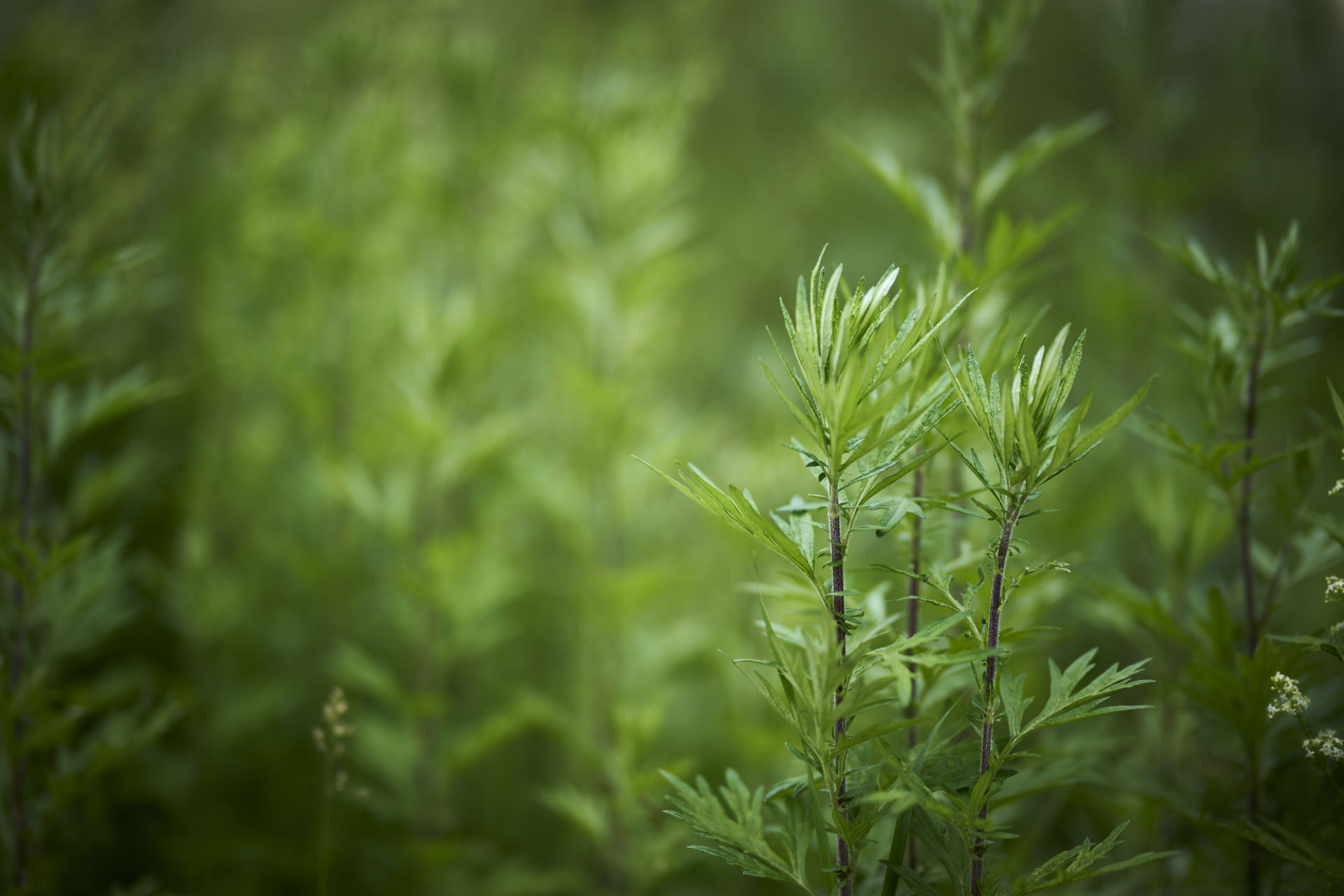
Viriditas: Musings on Magical Plants
Artemisia vulgaris
By Margaux Crump
Sign up for our monthly newsletter!
Mugwort is steadfast. It is the first herb I worked with beyond everyday cooking and has been with me ever since. A perennial plant from temperate Europe, Asia, and northern Africa, Artemisia vulgaris has dark green pinnately lobed leaves with distinctive silvery undersides. It is robust and spreads easily by rhizome, tending to grow in large stands where the soil has been disturbed, often with a leggy haphazard habit. When crushed and warmed in the hand, it releases a pungent, herbaceous scent that is revitalizing and opening. To my nose it recalls tarragon, epazote, and eucalyptus. When I inhale it, my shoulders drop and my eyes close. It’s a lovely aromatic.
A. vulgaris has long been used medicinally and magically, earning it monickers like Mother of Herbs and my personal favorite, Naughty Man. Its genus name, Artemisia, is said to either derive from Queen Artemisia II of Caria, who was a botanist, medical researcher, and naval commander, or from Artemis Ilithyia (Roman Diana), Greek goddess of the hunt, childbirth, and wildlife. The Old English Herbarium notes that, “… about the three plants that we call artemisia, it is said that Diana found them and gave knowledge of their power and medicinal value to the centaur Chiron, who was the first to prescribe a medicine using this plant and who named the plant artemisia after Diana.”1
“What is Venus, but the Artemisia that grows in your garden?”
Paracelsus
Mugwort’s healing properties were described by early medical writers such as Dioscorides, Galen, and Pliny the Elder, who tell us that it was primarily used for gynecological concerns, countering poison, gastrointestinal ailments, and fatigue. In traditional Chinese medicine, mugwort is ground and burnt in moxibustion, which can dredge meridians and stimulate the flow of qi and blood.”2 Recent research has demonstrated that A. vulgaris relaxes muscle spasms, prevents damage to the liver, relieves pain, and lowers high blood pressure, while also being antibacterial and antifungal.3 As a known emmenagogue, it was regularly employed for menstrual cycle regulation. In the 12th century Trotula, mugwort is recommended for inducing the menstrual cycle and for menopausal symptoms, as well as for uterine prolapse, easing birth, bringing about the after-birth, and encouraging conception.4 On the use of mugwort to induce menstruation, 15th century midwife Jane Sharp echoes the remedies of the Trotula, but in line with the laws of her time, cautions the reader to “ … do none of these things to women with child, for that will be murder.”5
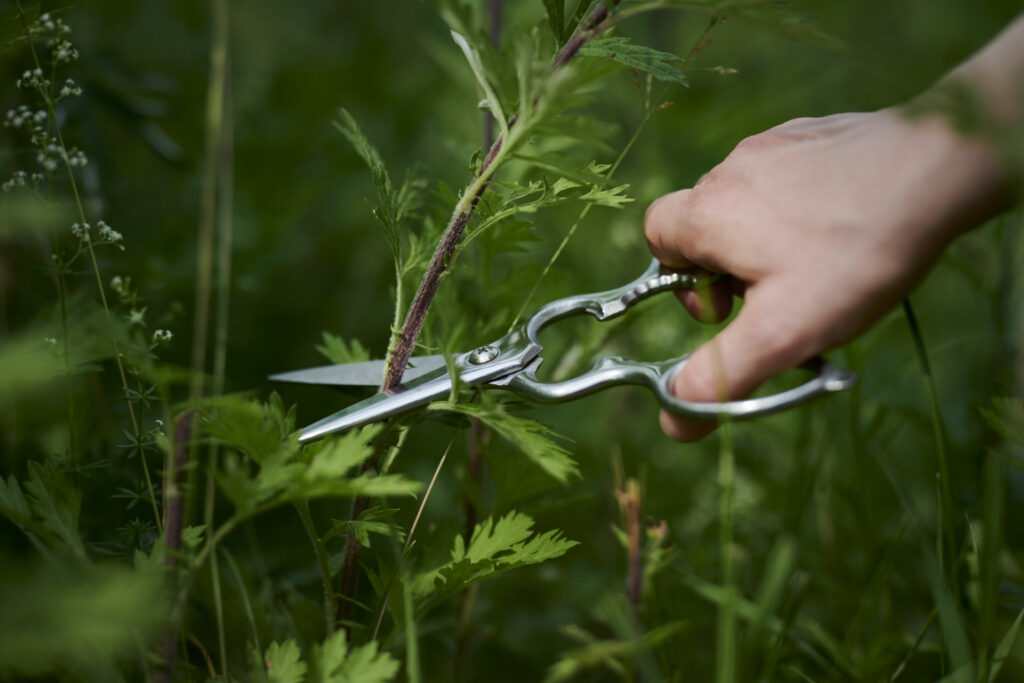
Today mugwort is commonly associated with the moon, sleep support, and dreamwork. This connection may be due to Artemis’ syncretization with the lunar goddess Selene. It could also be attributed to mugwort’s psychoactive compounds, such as α-thujone and β-thujone, which may induce vivid dreams.6 But the moon and mugwort were not always so intertwined. Speaking of the correspondences between plants, the stars, and the soul, the 14th century alchemist Paracelsus is said to have mused, “What is Venus, but the Artemisia that grows in your garden?”7 Similarly, Nicholas Culpeper lists mugwort as a venusian plant,8 which aligns with mugwort’s affinity for the internal reproductive organs and strong relaxant action. In the tradition of natural magic, Agrippa distributed mugwort to the astrological sign Libra, ruled by Venus. Like Ficino, he also lists mugwort as a receptor for the influences of the fixed stars Algol, the Goat-star (Capella), the Dog-star (Sirius), a star in the Heart of the Lion, the tail of the lesser Bear, Spica, and the tail of Capricorn.9
If you’ve never spoken to a plant, I invite you to explore what might happen when we shift our awareness to see the plants we grow, eat, and walk by as extended kinfolk, or at the very least generally peaceable neighbors.
One of my favorite magical references to mugwort is found in the Nigon Wyrta Galdor, commonly known as the Nine Herbs Charm (Harley MS 585). Recorded in Old English during the 10th or early 11th centuries, the galdor was meant to be sung directly to the plants and then into the mouth, ears, and wound of the person being healed. As a whole, the spell calls upon a retinue of healing plants, aided by the god Wōden (Odin), to defeat the forces that make us unwell. Mugwort is sung to in the first section below:
Remember, Mugwort,
what you brought to pass,
what you readied,
at Regenmeld.
You’re called Una, that most ancient plant.
You defeat three, you defeat thirty,
you defeat venom, you defeat air-illness;
you defeat the horror who stalks the land.10
I love that the Nigon Wyrta Galdor portrays mugwort as capable of communication, remembering, and direct action.11 While we cannot assume the Germanic people’s beliefs on the personhood of plants, we can allow the spirit of the spell to bring us into a deeper relationship with the plants in our lives. If you’ve never spoken to a plant, I invite you to explore what might happen when we shift our awareness to see the plants we grow, eat, and walk by as extended kinfolk, or at the very least generally peaceable neighbors.
Expanding its magical repertoire, Mugwort was also used to protect travelers. Dioscorides notes that, “If anyone has the herb artemisia with him while travelling it dissolves weariness, and if you wear it on your feet it drives away venomous beasts and devils.”12 The Old English Herbarium repeats this and adds that it also “expels demonic possession … and turns away the evil eye.”13 An entry in Bald’s Leechbook (Royal MS 12 D XVII) goes a step further, providing harvesting instructions:
For a long journey over land, in case he tires, he should take mugwort in hand or put it in his shoe in case he grows weary, and when he wants to take it before the rising of the sun he should say these words first: ‘I will take you, O mugwort, (so that) I am not tired on the road.’ Make the sign (of the cross) on them when you take them up.14
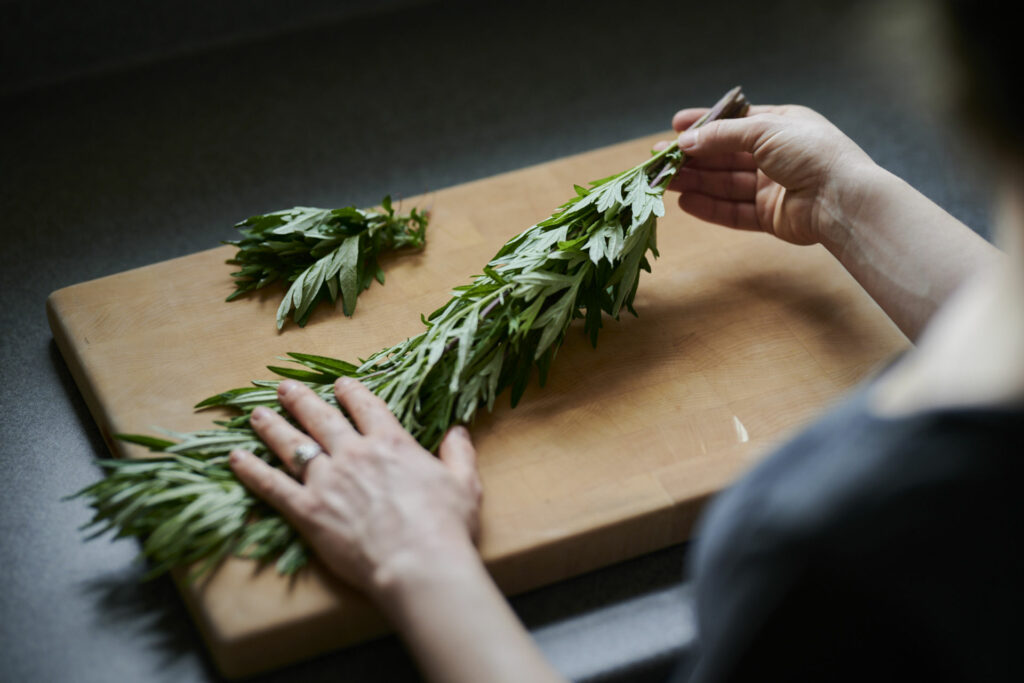
In my own practice, I like to work with mugwort as smoke for clearing. I find it helpful in opening what is constricted and moving out what is stagnant, both internally and externally. Mugwort’s propensity for intangible clearing is mirrored in its ability to cleanse the body of tangible parasites. Though less effective than the closely related and aptly named wormwood (Artemisia absinthium), both species have demonstrated anthelmintic activity in recent studies.15 One of the ways we can attune to a plant’s esoteric attributes is to observe its morphology and ecologic behavior. We can further sense mugwort’s propensity for clearing in its allelopathic properties. The presence of monoterpenoid compounds concentrated in the soil within and bordering mugwort stands suggests that A. vulgaris releases its own monoterpene herbicide, allowing it to quickly dominate an area.16 In essence, mugwort clears competing plants from the soil where it wants to grow.
Artemisia vulgaris is categorized as a noxious weed in many habitats. When possible, please plant the species native to your area or harvest A. vulgaris responsibly where it is growing wild. To help control the spread of Mugwort, harvest the plant in its entirety before it flowers. If you’d like to increase the potency of your harvest, consider harvesting when the moon is in Taurus or Libra, two signs ruled by Venus or follow the advice in Bald’s Leechbook and collect before sunrise.
Harvesting and Drying A. vulgaris
In my garden, I harvest right before the flowers open and just before sunrise. After greeting the plant and asking for permission, I clip stalks about 8–12 inches long, leaving generous foliage at the base of the plant to encourage a robust bushy habit. I then gently shake the stems and lay them on a clean cloth in the shade for a few minutes to encourage insects to leave. From here, I pick out any foliage that is wilted or browning so I have healthy stems for drying. I also check for any creatures who may be hiding so I can remove them and avoid bringing anyone indoors. If you are gathering from a dusty area, follow this by rinsing the stems in cool water and shaking them off.
Once inside, I divide my stems into bundles about the diameter of a nickel or a quarter. The key is to make sure there is enough airflow within the foliage for even drying. Using kitchen twine or thin rubber bands, I tie the bundles and hang them from a drying rack or an upper kitchen cabinet knob. Mugwort dries beautifully in bundles hanging upside down. Once dry, the leaves have myriad uses, but I mostly find myself burning the loose leaves for smoke cleansing or brewing them as a digestive tea.
Margaux Crump (b.1989, USA) is a gardener and interdisciplinary artist exploring the entanglements between ecology, spirituality, and power. She is currently investigating the phenomena of unseen worlds, from the microscopic to the parallel mythic realms that surround us. Follow her on instagram @margauxcrump
Sources
1 Anne Van Arsdall, Medieval Herbal Remedies: The Old English Herbarium and Anglo-Saxon Medicine (United Kingdom: Routledge, 2002), 153.
2 Deng H, Shen X. The mechanism of moxibustion: ancient theory and modern research. Evid Based Complement Alternat Med. 2013;2013:379291. doi: 10.1155/2013/379291. Epub 2013 Sep 12. PMID: 24159344; PMCID: PMC3789413.
3 Ekiert H, Pajor J, Klin P, Rzepiela A, Ślesak H, Szopa A. Significance of Artemisia Vulgaris L. (Common Mugwort) in the History of Medicine and Its Possible Contemporary Applications Substantiated by Phytochemical and Pharmacological Studies. Molecules. 2020 Sep 25;25(19):4415. doi: 10.3390/molecules25194415. PMID: 32992959; PMCID: PMC7583039.
4 Monica H. Green, ed. The Trotula: An English Translation of the Medieval Compendium of Women’s Medicine (University of Pennsylvania Press, 2002)
5 Jane Sharp. The Midwives Book: Or the Whole Art of Midwifry Discovered (United States: Oxford University Press, USA, 1999), 221.
6 Michael Albert-Puleo. “Mythobotany, Pharmacology, and Chemistry of Thujone-Containing Plants and Derivatives.” Economic Botany 32, no. 1 (1978): 65–74. http://www.jstor.org/stable/4253892.
7 Franz Hartmann. The Life of Philippus Theophrastus Bombast of Hohenheim Paracelsus – Scholar’s Choice Edition (United Kingdom: Creative Media Partners, LLC, 2015), 288.
8 Nicholas Culpeper, Culpeper’s Complete Herbal & English Physician (United States: Applewood Books, 2007), 122–123. First published 1653.
9 Heinrich Cornelius Agrippa, Three Books of Occult Philosophy: Book One – Natural Magic, trans. Willis F Whitehead, (Chicago: Hahn & Whitehead, 1898). First published 1531.
10 Translation by Joseph S. Hopkins for Mimisbrunnr.info, 2020.
11 A deeper discussion of relational autonomy and the Nine Herbs Charm can be found in: Matthew Hall, Plants as Persons: A Philosophical Botany (New York: State University of New York Press, 2011) 128–129.
12 Dioscorides Pedanius, Tess Anne Osbaldeston, Robert P. A. Wood. De Materia Medica: Being an Herbal with Many Other Medicinal Materials Written in Greek in the First Century of the Common Era (South Africa: Ibidis, 2000), 513.
13 Anne Van Arsdall, Medieval Herbal Remedies: The Old English Herbarium and Anglo-Saxon Medicine (United Kingdom: Routledge, 2002), 152.
14 Conan Turlough Doyle, “Anglo-Saxon Medicine and Disease: A Semantic Approach,” PhD diss., (University of Cambridge, 2017) Apollo – University of Cambridge Repository. doi:10.17863/CAM.14430.
15 Caner A., Döşkaya M., Deǧirmenci A., Can H., Baykan Ş., Üner A., Başdemir G., Zeybek U., Gürüz Y. Comparison of the effects of Artemisia vulgaris and Artemisia absinthium growing in western Anatolia against trichinellosis (Trichinella spiralis) in rats. Exp. Parasitol. 2008;119:173–179. doi: 10.1016/j.exppara.2008.01.012.
16 Jacob N. Barney, Jed P. Sparks, Jim Greenberg, Thomas H. Whitlow, and Alex Guenther. “Biogenic Volatile Organic Compounds from an Invasive Species: Impacts on Plant-Plant Interactions.” Plant Ecology 203, no. 2 (2009): 195–205. http://www.jstor.org/stable/40305728.
Plantings
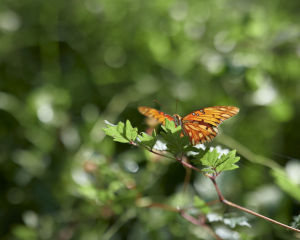
The Ecological Impact and Potential of the American Lawn
By Jake Eshelman
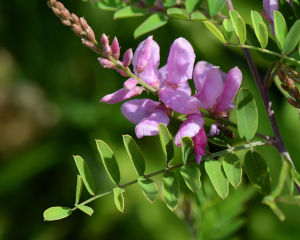

Working the Garden and Spirit: An Interview with Maria Rodale
By Gayil Nalls
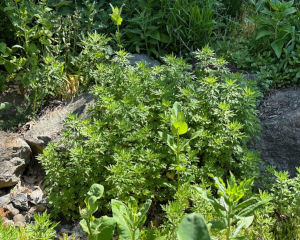
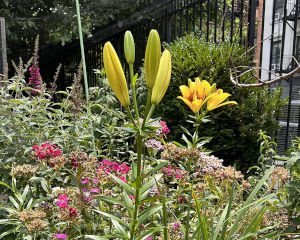
Green Oases:
NYC’s Community Gardens
By Olivia Mermagen
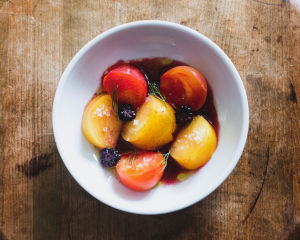
Eat More Plants Recipes:
Heirloom Tomato with Fermented Blackberries and Roasted Kale Stem Oil
By Tessa Liebman

As Ireland transitions from the rich, smoky scent of peat-burning to a more sustainable future, its olfactory heritage is evolving. What will become the next iconic aromatic symbol of Ireland?
Click to watch the documentary trailer.


